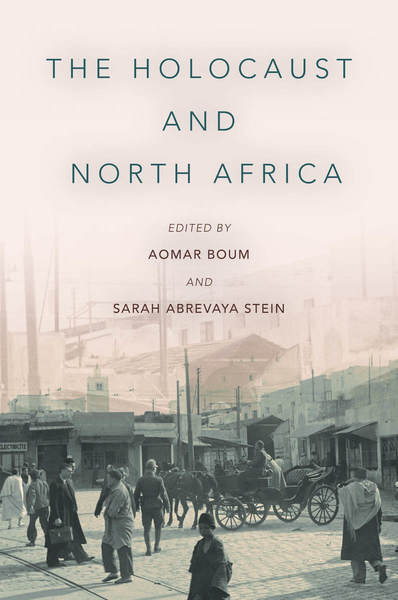

Over the last decade, historians have shown growing interest in encounters between Nazism and the Arab world. Few, however, have focused so extensively on the course of the Holocaust in the Maghreb as the contributors to The Holocaust and North Africa. Still fewer have taken on the task of integrating this region simultaneously into the broader Shoah and decolonial historiographies. Part of the reason is the marginality of this region. Relatively few Jews lived in Libya, Tunisia, Morocco, and French West Africa. The Algerian population was slightly larger, but the total regional population numbered just several hundred thousand. What is more, the Nazi extermination project targeted the Ashkenazi populations of Europe first and foremost. Because of this, the expansion of the persecution to North Africa was hitherto considered an afterthought. This volume argues effectively, however, that the experiences of North Africa’s Jews, as well as Arabs, Berbers, and sub-Saharan Africans, of the policies carried out under Nazi, Italian, and Vichy supervision must be examined in order to understand the Holocaust as an uneven but pervasive phenomenon. It is more than just the bloodlands of Eastern Europe and the transit camps of the Western Europe. It also took shape at its peripheries, where the persecution was often carried out with rare obsession—targeting the scant 110 Jewish families in French West Africa, for instance—and where policies encountered sociocultural networks and political realities that were quite different from those in Europe.
Growing out of a 2015 conference “On the Margins of the Holocaust: Jews, Muslims, and Colonialism in North Africa During the Second World War” The Holocaust and North Africa sets out “to flesh out our understanding of the ways the Holocaust unfolded in North Africa, a region considered marginal… to the racial and genocidal policies of the Nazis and their allies.” (2) To do so, it is broken into four sections addressing the intersection of fascism and colonialism, experiences of the wartime occupations and the imposition of European race laws, personal narratives of the occupation, and commentaries on the greater project of studying the colonial spaces of what is normally considered a German and European phenomenon.
The first section spans Axis North Africa. Together, these chapters tell a variegated story of occupation and discrimination. Indeed, as several contributors note, the Holocaust is not just the destruction of the Jews, but the policies imposed with the intention of persecuting Jewish inhabitants throughout Nazi and Axis-controlled territories. Therefore, to gain a fuller understanding of the Holocaust and its aftermath, researchers must expand beyond the Central and Eastern European foci of prior decades of study and incorporate the experiences of those Sephardim victimized in distinct ways by the same antisemitic system. As the first section makes clear, the differing forms of persecution were largely dictated by the socio-political landscape of the places and populations in which the measures were applied. In Libya, for instance, persecution occurred against the backdrop of an Italian administration deeply unpopular because of its recent invasion of Ethiopia and fueled by an anti-Jewish fervor that was largely foreign to mainland Italians. It was only after the British took control of Libya in the middle of 1943 that Jews were confronted with strong local expressions of antisemitism including pogroms, though even these actions and attitudes were exacerbated if not shaped by years of colonization and the subsequent British occupation.
Most other contributions to this volume focus on Francophone North Africa. A critical pivot for many of these is the 1940 revocation of the Crémieux Decree. Enacted in 1870, this law had granted Algerian Jews, but not Muslims, French citizenship. It therefore served as a potent wedge and major point of contention between the Muslim and Jewish populations. Interestingly, in the protectorates of Tunisia and Morocco, the colonial administrations refused to categorize indigenous Jews by European racial categories, fearing such a special identification would disrupt the colonial administrative structures. In the end, although anti-Semitism underlay the eventual imposition of taxonomies of European and North African indigeneity during the Vichy regime, this “was more about Muslims and the rising tide of nationalism than about Jews.” (47) The course of the Holocaust in Vichy protectorates, in other words, was shaped here not just by Axis plans, but by local social structures and political movements.
Axis policy in North Africa took on its most visible manifestations in the usual forms: intensifying political, social, and legal exclusion of Jews, the removal of Jews from office, the confiscation of Jewish property, and the deportation of Jews to a small system of local concentration camps. In places such as French West Africa and Morocco, the Jewish populations were small enough to avoid the worst of effects of Vichy legislation, even as administrators such as General Henri Giraud doggedly pursued them and Vichy legal policies actively encouraged Muslim court cases against Jewish landowners and lenders. In places such as Algeria and Tunisia, Jews were rounded up in labor camps such as the repurposed military outpost in Bedeau and the Moroccan camp Djelfa. How does one write an account of the lesser, though all too real suffering of those who survived the North African Shoah? Each contribution to this volume offers a potential answer to this question, revealing a diversity of methodologies and narrative threads that open the door to a trans-Mediterranean history of the Holocaust. Although any answer must nevertheless be partial and, at this early stage of what promises to be a prolonged exploration of this period of North African Jewish history, the pursuit of the answer is nevertheless essential, as Alma Rachel Heckman writes, to “nuancing the story of the Holocaust in its marginal theaters.” (204) Only after we understand its borders and contours can we understand the Holocaust as the uneven yet encompassing catastrophe that it was.
Some of the strongest contributions to this volume fall in the third section and deal directly with North African Jewish narratives of the Vichy and Nazi occupations. These are particularly impactful as they tell hitherto ignored stories about the Holocaust in North Africa as a triple isolation: not only isolation in the sense of internment or social death but also isolation from the experiences of European Jews and, in the case of Alma Rachel Heckman’s study of Moroccan Jewish communists, the isolation of being a political outcast, as well. The final section offers a series of commentaries that ground the previous chapters in current historiographical and political debates. Many of these make cases for a variegated Holocaust, wherein less suffering or extra-European locality should not mean liminality or invisibility. Susan Rubin Suleiman identifies the concept of “inclusion with diversity,” wherein scholars seek to examine a singular historical event from multiple perspectives in order to untie the different groups, experiences, and memories that can help us gain a richer, per Michael Rothberg, “multidirectional” understanding than the streamlined, essentializing approach to the Shoah as monolith encourages. (216) Several other essays make the case for removing the stigma of the relatively mild experiences of the Sephardim in order to better incorporate their stories into our evolving canon. This is not just for academic historical purposes or even simply to better understand these unique sites of colonial-Holocaust intersectionality. It is also necessary because of the tangible implications of such acknowledgement. On the one hand, recognition grants affirmation to the experiences of thousands of Jews who, even in Israel, have born the stigma of not being early Zionists or, especially after the Holocaust became the founding event of national memory, of European ancestry. On the other hand, such recognition has important implications for the system of compensation most prominently through the Conference on Material Jewish Claims against Germany, a point mentioned several times throughout this volume.
Although such reiteration can be helpful, the volume sometimes suffers from too much of it. By the third introduction of the Crémieux Decree, the reader understands its importance and no longer needs the tedious rudiments of its history. The final section likewise overplays the tactic of repetition, albeit to more ambiguous effect. Although I found most of these essays quite illuminating, the section itself seemed a succession of conclusions, any one of which could have efficiently closed the volume. This may be an exercise exhibiting the rich variety of nuanced perspectives one can attach to a singular volume, a sort of “multidirectional” approach to the classic conclusion. Nevertheless, as strong as these chapters were, I found the section, as a whole, a somewhat awkward series of endings.
These, of course, are minor critiques of issues inherent to the project of collecting such a tight and incisive array of essays on such a specific and understudied topic. Moreover, they should not detract from the fact that this is an important and timely book. It balances microhistories with more sweeping historiographical arguments. It offers insights not only into the administration of the Holocaust and its relationship with mid-century colonial practices, but also into how these processes affected Muslim-Jewish relations throughout the Maghreb. One cannot simply blame European anti-Semitism, World War II, or colonialism for the postwar mass expulsion of Jews from the region and Jewish-Muslim tensions. This volume nevertheless makes clear that these interventions played a role. And for that reason alone, this volume is a unique and welcome addition to our understandings of the mid-twentieth century Maghreb, the death throes of European colonization, the Shoah, and the ways in which these sites, events, and memories continue to shape the Mediterranean region today.
Nicholas Ostrum received his Ph.D. in History from Stony Brook University in 2017. He is currently an instructor at the University of New Orleans and Clark State Community College and a member of EuropeNow’s Research Editorial Committee.
The Holocaust and North Africa
Edited by Aomar Boum and Sarah Abrevaya Stein
Publisher: Stanford University Press
Paperback / 349 pages / 2019
ISBN: 9781503607057
Published on March 10, 2020.




